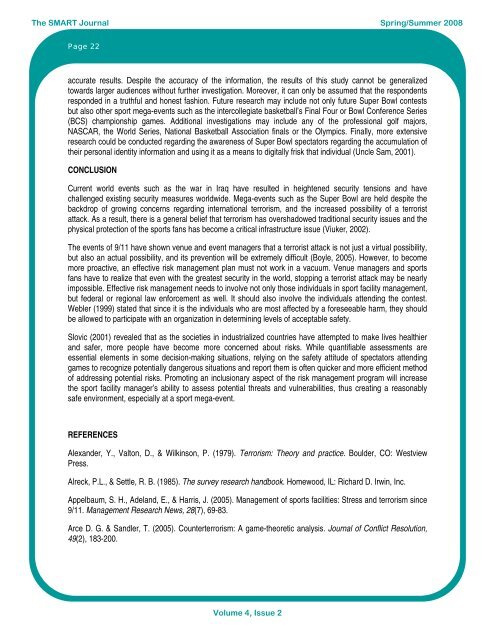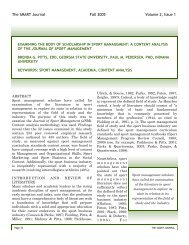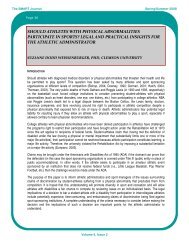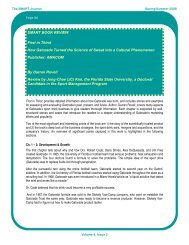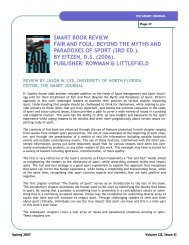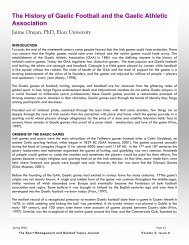Spring/Summer 2008 Volume 4, Issue 2 - The SMART Journal
Spring/Summer 2008 Volume 4, Issue 2 - The SMART Journal
Spring/Summer 2008 Volume 4, Issue 2 - The SMART Journal
Create successful ePaper yourself
Turn your PDF publications into a flip-book with our unique Google optimized e-Paper software.
<strong>The</strong> <strong>SMART</strong> <strong>Journal</strong> <strong>Spring</strong>/<strong>Summer</strong> <strong>2008</strong><br />
Page 22<br />
accurate results. Despite the accuracy of the information, the results of this study cannot be generalized<br />
towards larger audiences without further investigation. Moreover, it can only be assumed that the respondents<br />
responded in a truthful and honest fashion. Future research may include not only future Super Bowl contests<br />
but also other sport mega-events such as the intercollegiate basketball’s Final Four or Bowl Conference Series<br />
(BCS) championship games. Additional investigations may include any of the professional golf majors,<br />
NASCAR, the World Series, National Basketball Association finals or the Olympics. Finally, more extensive<br />
research could be conducted regarding the awareness of Super Bowl spectators regarding the accumulation of<br />
their personal identity information and using it as a means to digitally frisk that individual (Uncle Sam, 2001).<br />
CONCLUSION<br />
Current world events such as the war in Iraq have resulted in heightened security tensions and have<br />
challenged existing security measures worldwide. Mega-events such as the Super Bowl are held despite the<br />
backdrop of growing concerns regarding international terrorism, and the increased possibility of a terrorist<br />
attack. As a result, there is a general belief that terrorism has overshadowed traditional security issues and the<br />
physical protection of the sports fans has become a critical infrastructure issue (Viuker, 2002).<br />
<strong>The</strong> events of 9/11 have shown venue and event managers that a terrorist attack is not just a virtual possibility,<br />
but also an actual possibility, and its prevention will be extremely difficult (Boyle, 2005). However, to become<br />
more proactive, an effective risk management plan must not work in a vacuum. Venue managers and sports<br />
fans have to realize that even with the greatest security in the world, stopping a terrorist attack may be nearly<br />
impossible. Effective risk management needs to involve not only those individuals in sport facility management,<br />
but federal or regional law enforcement as well. It should also involve the individuals attending the contest.<br />
Webler (1999) stated that since it is the individuals who are most affected by a foreseeable harm, they should<br />
be allowed to participate with an organization in determining levels of acceptable safety.<br />
Slovic (2001) revealed that as the societies in industrialized countries have attempted to make lives healthier<br />
and safer, more people have become more concerned about risks. While quantifiable assessments are<br />
essential elements in some decision-making situations, relying on the safety attitude of spectators attending<br />
games to recognize potentially dangerous situations and report them is often quicker and more efficient method<br />
of addressing potential risks. Promoting an inclusionary aspect of the risk management program will increase<br />
the sport facility manager’s ability to assess potential threats and vulnerabilities, thus creating a reasonably<br />
safe environment, especially at a sport mega-event.<br />
REFERENCES<br />
Alexander, Y., Valton, D., & Wilkinson, P. (1979). Terrorism: <strong>The</strong>ory and practice. Boulder, CO: Westview<br />
Press.<br />
Alreck, P.L., & Settle, R. B. (1985). <strong>The</strong> survey research handbook. Homewood, IL: Richard D. Irwin, Inc.<br />
Appelbaum, S. H., Adeland, E., & Harris, J. (2005). Management of sports facilities: Stress and terrorism since<br />
9/11. Management Research News, 28(7), 69-83.<br />
Arce D. G. & Sandler, T. (2005). Counterterrorism: A game-theoretic analysis. <strong>Journal</strong> of Conflict Resolution,<br />
49(2), 183-200.<br />
<strong>Volume</strong> 4, <strong>Issue</strong> 2


